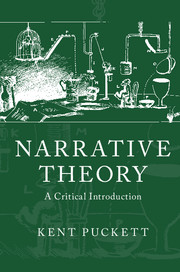Book contents
- Frontmatter
- Contents
- Acknowledgments
- Chapter 1 Introduction: Story/Discourse
- Chapter 2 Action, Event, Conflict: The Uses of Narrative in Aristotle and Hegel
- Chapter 3 Lost Illusions: Narrative in Marx, Nietzsche, and Freud
- Chapter 4 Epic, Novel, Narrative Theory: Henry James, Georg Lukács, Mikhail Bakhtin, and Erich Auerbach
- Chapter 5 Form, Structure, Narrative: Propp, Shklovsky, Saussure, Lévi-Strauss
- Chapter 6 Narratology and Narrative Theory: Kristeva, Barthes, and Genette
- Bibliography
- Notes
- Suggested Further Reading
- Index
Chapter 5 - Form, Structure, Narrative: Propp, Shklovsky, Saussure, Lévi-Strauss
Published online by Cambridge University Press: 01 December 2016
- Frontmatter
- Contents
- Acknowledgments
- Chapter 1 Introduction: Story/Discourse
- Chapter 2 Action, Event, Conflict: The Uses of Narrative in Aristotle and Hegel
- Chapter 3 Lost Illusions: Narrative in Marx, Nietzsche, and Freud
- Chapter 4 Epic, Novel, Narrative Theory: Henry James, Georg Lukács, Mikhail Bakhtin, and Erich Auerbach
- Chapter 5 Form, Structure, Narrative: Propp, Shklovsky, Saussure, Lévi-Strauss
- Chapter 6 Narratology and Narrative Theory: Kristeva, Barthes, and Genette
- Bibliography
- Notes
- Suggested Further Reading
- Index
Summary
There are moments that are made up of too much stuff for them to be lived at the time they occur.
John le Carré, Tinker, Tailor, Soldier, SpyIn the previous chapter I discussed several theorists of narrative who shared a commitment to what I called the comparative analysis of narrative forms. In other words, Lukács, Bakhtin, and Auerbach each developed a distinct critical methodology around two implicit or explicit but nonetheless axiomatic claims. The first is that narrative, understood as the reciprocal relation between story and discourse, represents a more or less universal means of engaging with, processing, and organizing the world. On the basis of ideas resulting from Hegel's effort to think about history as a whole and significant story of consciousness realizing itself and a Neo-Kantian effort to reimagine and to reinvigorate Kant's sense of the reciprocal relation between conceptual categories and lived experience, Lukács, Bakhtin, and Auerbach each accept both that living in the world requires that we narrate the world to ourselves and to others and that the formal demands of narrative – that story needs to find expression in discourse in order to be communicable – remain more or less stable. The second axiomatic claim is that, although narrative itself is more or less stable, the particular forms that it takes in different places at different moments in time are radically different because radically historical. That is to say, while we can treat narrative (which is to say the narrative relation between story and discourse) as a kind of given, the history of narrative, which Lukács, Bakhtin, and Auerbach understand as the history of narrative genres, is not at all given; it is contingent, cultural, and subject to all manner of social and political pressures. And, although they all think very differently about the mechanism that allows for the move from one narrative genre as a culture's dominant genre (epic, tragedy, novel, etc.), they nonetheless accept that there is a deep relation between the character of a culture and the character of the genres that a culture uses to describe itself to itself and to others. As a result, the comparative analysis of narrative genres allows both for a more precise understanding of the nature of narrative as narrative and for a rigorously historical analysis of particular cultures and their stories at particular times.
- Type
- Chapter
- Information
- Narrative TheoryA Critical Introduction, pp. 176 - 222Publisher: Cambridge University PressPrint publication year: 2016



